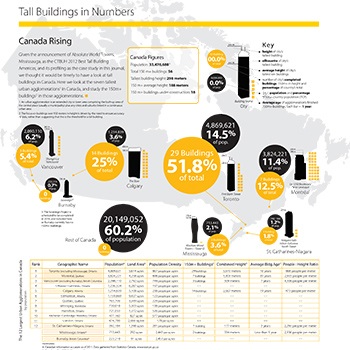Filter by
You must be a CTBUH Member to view this resource.
ÏCE Condominiums at York Centre 2
ICE Condominiums East
Building
Completed, 2015
M5J 0B1
residential
concrete
234.2 m / 768 ft
67
5
743
172
10
2.5 m/s
48,521 m² / 522,276 ft²
You must be a CTBUH Member to view this resource.
You must be a CTBUH Member to view this resource.
Proposed
Construction Start
Completed
Usually involved in the front end design, with a "typical" condition being that of a leadership role through either Schematic Design or Design Development, and then a monitoring role through the CD and CA phases.
Other Consultant refers to other organizations which provided significant consultation services for a building project (e.g. wind consultants, environmental consultants, fire and life safety consultants, etc).
You must be a CTBUH Member to view this resource.
Usually involved in the front end design, with a "typical" condition being that of a leadership role through either Schematic Design or Design Development, and then a monitoring role through the CD and CA phases.
The Design Engineer is usually involved in the front end design, typically taking the leadership role in the Schematic Design and Design Development, and then a monitoring role through the CD and CA phases.
The Design Engineer is usually involved in the front end design, typically taking the leadership role in the Schematic Design and Design Development, and then a monitoring role through the CD and CA phases.
The main contractor is the supervisory contractor of all construction work on a project, management of sub-contractors and vendors, etc. May be referred to as "Construction Manager," however, for consistency CTBUH uses the term "Main Contractor" exclusively.
Other Consultant refers to other organizations which provided significant consultation services for a building project (e.g. wind consultants, environmental consultants, fire and life safety consultants, etc).
These are firms that consult on the design of a building's façade. May often be referred to as "Cladding," "Envelope," "Exterior Wall," or "Curtain Wall" Consultant, however, for consistency CTBUH uses the term "Façade Consultant" exclusively.
Material Supplier refers to organizations which supplied significant systems/materials for a building project (e.g. elevator suppliers, facade suppliers, etc).
Seven Cities Winter Spaces Walking Tour
29 January 2015 - Event
CTBUH Canada Tours ICE Condos at York Center, Toronto
19 November 2014 - Event

18 October 2016 | Toronto
The Space Between: Urban Spaces Surrounding Tall Buildings
This presentation was intended to introduce the upcoming CTBUH technical guide titled "The Space Between," which investigates the importance of publicly accessible spaces surrounding tall...

01 December 2012
CTBUH Research
Twenty-six buildings taller than 150 meters have been built in Canada since 2005 and it added four buildings taller than 200 meters in 2012, the...
29 January 2015
The new CTBUH Urban Habitat / Urban Design Committee organized a highly successful Winter Spaces Walking Tour in seven cities around the world.
19 November 2014
The CTBUH Canada chapter hosted a tour – ironically during an early winter snow storm – of the ICE Condominiums.
Subscribe below to receive periodic updates from CTBUH on the latest Tall Building and Urban news and CTBUH initiatives, including our monthly newsletter. Fields with a red asterisk (*) next to them are required.
View our privacy policy